Popular Highlights
When only a watchmaker will do
Restoration of Omega Jump Seconds Clock
| Approach To Service |
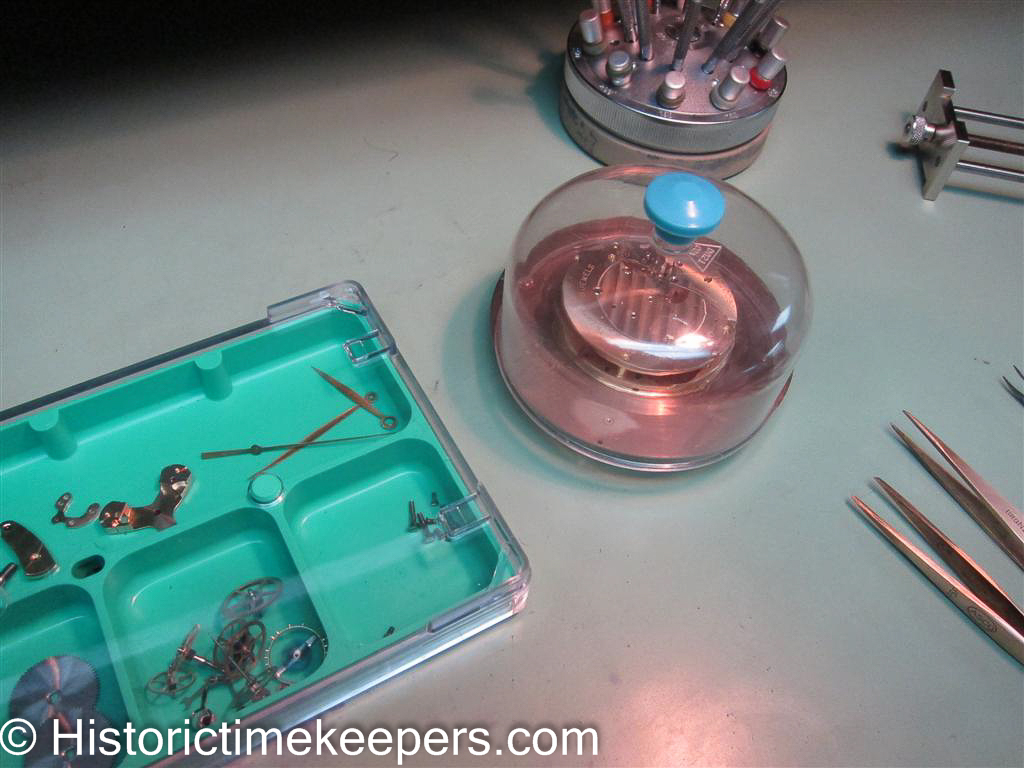 |
When a timepiece arrives in my shop, I partially disassemble it and note all the defects I find. I then provide a quote to the customer with the proviso that upon complete disassembly and cleaning some other things might pop up. But, I know what tends to go bad in most situations, and I can generally tell when I really need to be careful based on the workmanship I find from the previous repairs. I send the quote (along with photos if relevant) for approval by the customer.

Note: I no longer use a loupe for very much. 99% of bench work is under the microscope.
Every timepiece is fully disassembled before initial cleaning. This means every cap jewel is removed, the mainspring is removed from the barrel, every screw removed. The parts are then precleaned using jars in a 3 qt Branson ultrasonic machine to remove as much of the grit and old lubricant as possible. This saves the cleaning and rinse solutions in the final cleaning machine, a four jar machine that meets the requirements established by most watch manufacturers. This Tempo 355 was upgraded to a Temp 400 for what I consider little money by Richard Wong of Electronic Instrument Services. He also serviced my MU-700 when it needed it. Highly recommend him.
This view also shows my shellacking and heat treating area. I use the hot plate for a number if things, but tempering and blueing steel is one important use. I also use it to make my pallet adjuster warm, place it on the tile, move that to my bench where I can adjust under the microscope. The soldering iron and gun are used for various functions, one of the most useful being loosening chronograph drive wheels that have been driven on too far. Stuck chronograph drive wheels are the primary source of damage to the 4th pinion and arbor and the arbor's hole jewel. You can also see my demagnetizer is at hand.
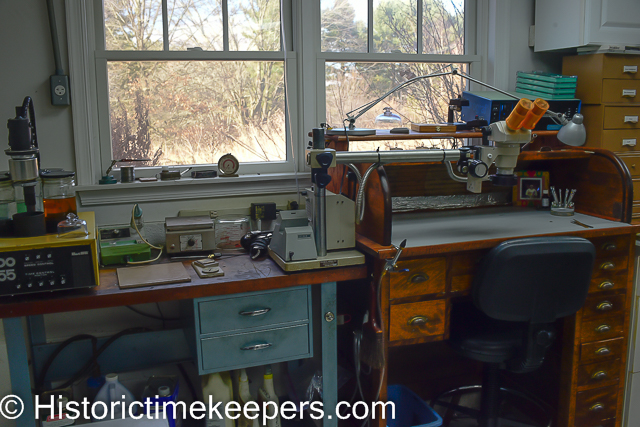
The cleaning and rinse solutions are petroleum based so the cost goes up with the price of oil. Aside from cost, disposal is an important responsibility. Spent cleaners are given to my auto mechanic and the rinse is disposed of by using as fuel in my garden tractor.
After cleaning every part is inspected. Pivots are refinished as needed, jewels inspected for damage, screws are refinished as appropriate. The two jars on my bench are reagent grade heptane and reagent grade isopropyl alcohol. These are used with swabs made from surgical sponge to remove any deposits that may have resisted the machine cleaning.
Here is a view that shows how my layout is very convenient for all normal watch service operations. My bench microscope swings away from the bench, my Mu-700 is in a convenient and out of the way spot, and I have another microscope set up on the bench to the left to inspect jewels and verify lubrication with under lighting. Much of my material is to the right of the workbench and the drawers underneath the counter hold my staking tools, presses, larger anvils and my oil bottles and other supplies.
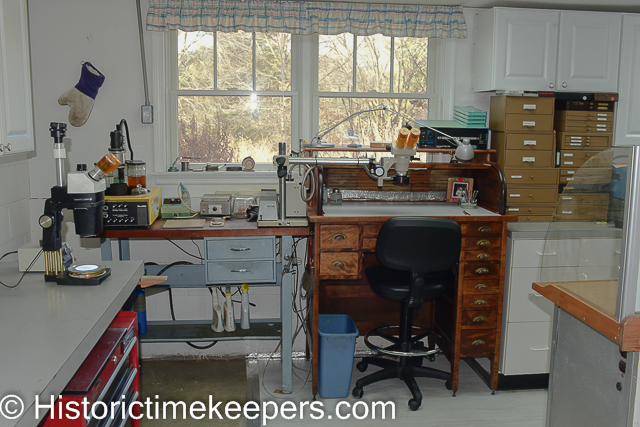
Also worth pointing out is the Aluminum Duct tape around the floor joints and on the bench back. It prevents undue distress when a part flips away. I put linoleum tiles in the main seating area to make it easier to clean and find parts that drop.
To the left is a very badly cut pivot from being in use long after the lubrication evaporated. To the right is the renewed pivot.
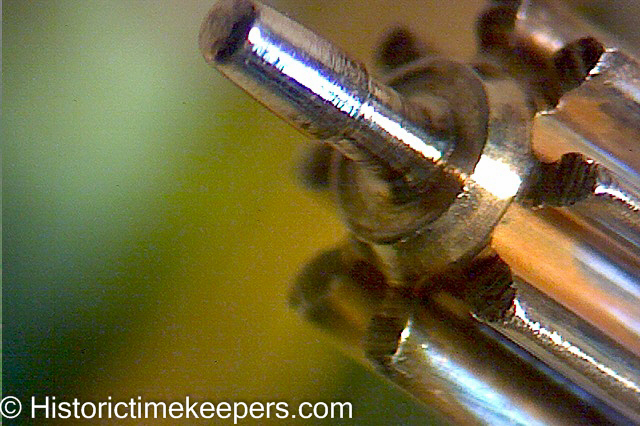
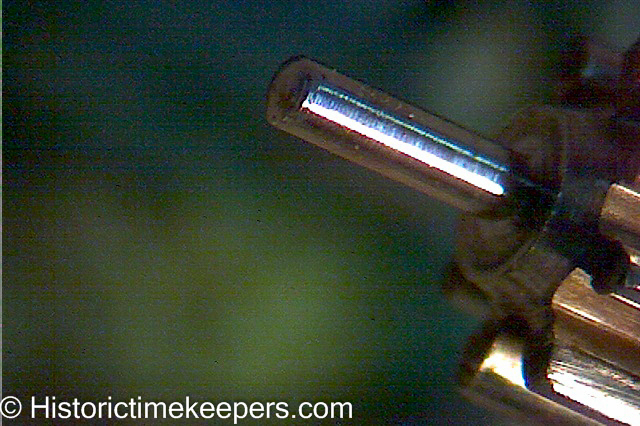
I have a Bausch and Lomb StereoZoom 7 (10X to 70X) for close inspection and taking photos for customers (Very easy with a tilt screen camera like a Nikon D750). Today you can take very high quality microphotographs that were beyond the reach of most individuals only 20 years ago and with much less setup.
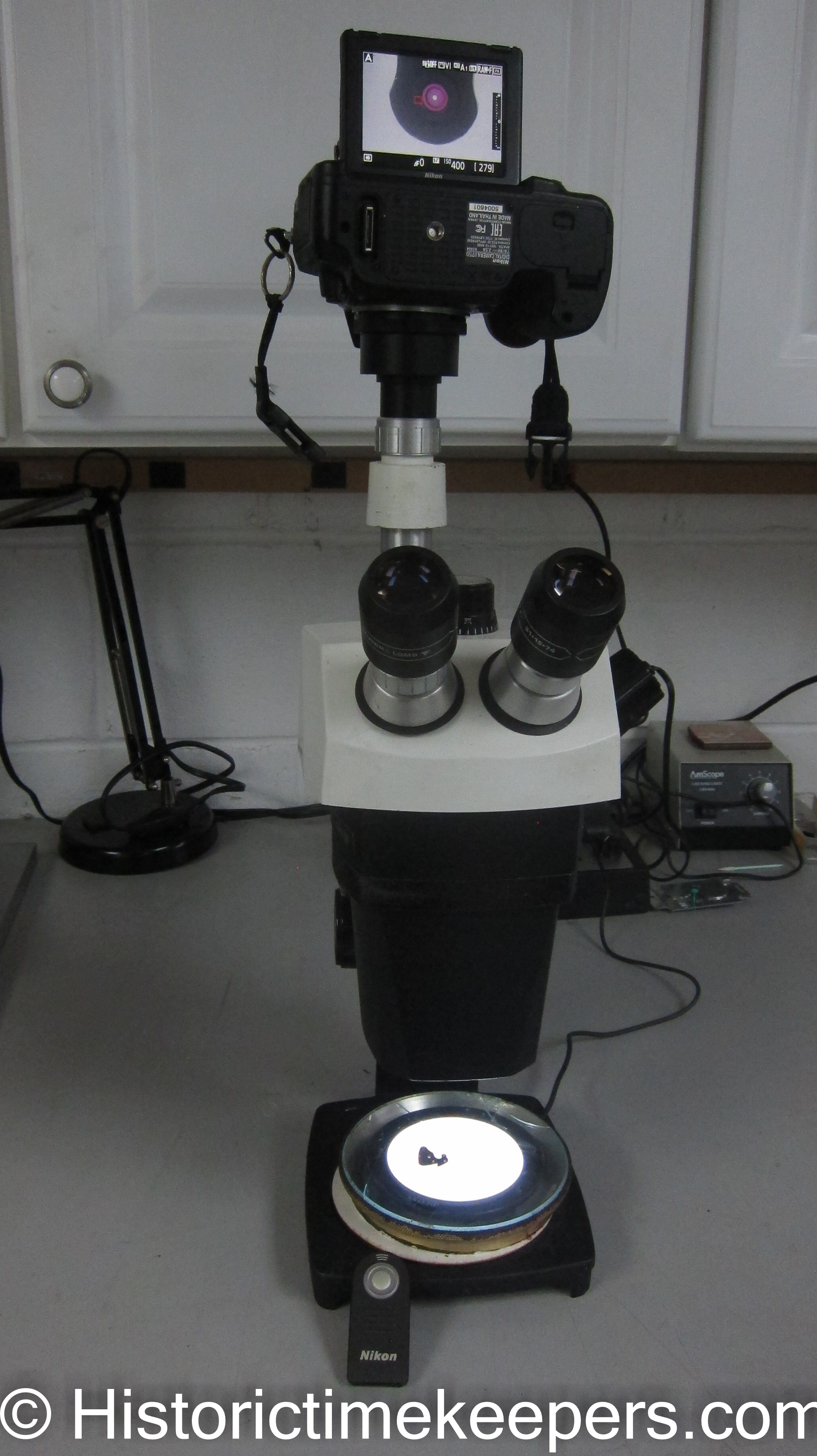
Above: Documenting jewel holes with Bausch microscope and Nikon tilt screen camera. Note use of wireless shutter release.
To learn more about the usefulness of microscopes, visit our Microscopes in Watchmaking page.
Below is a Hamilton 37500 aircraft clock's several hundred individual pieces cleaned and ready for inspection.
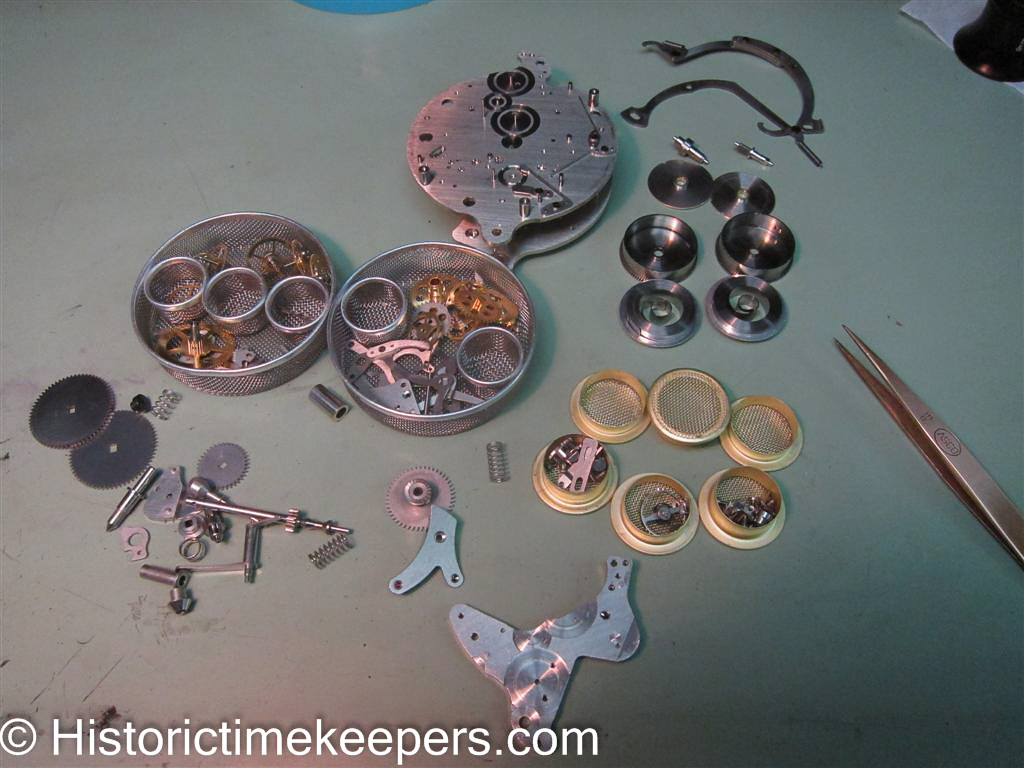
This is a marine chronometer being assembled.
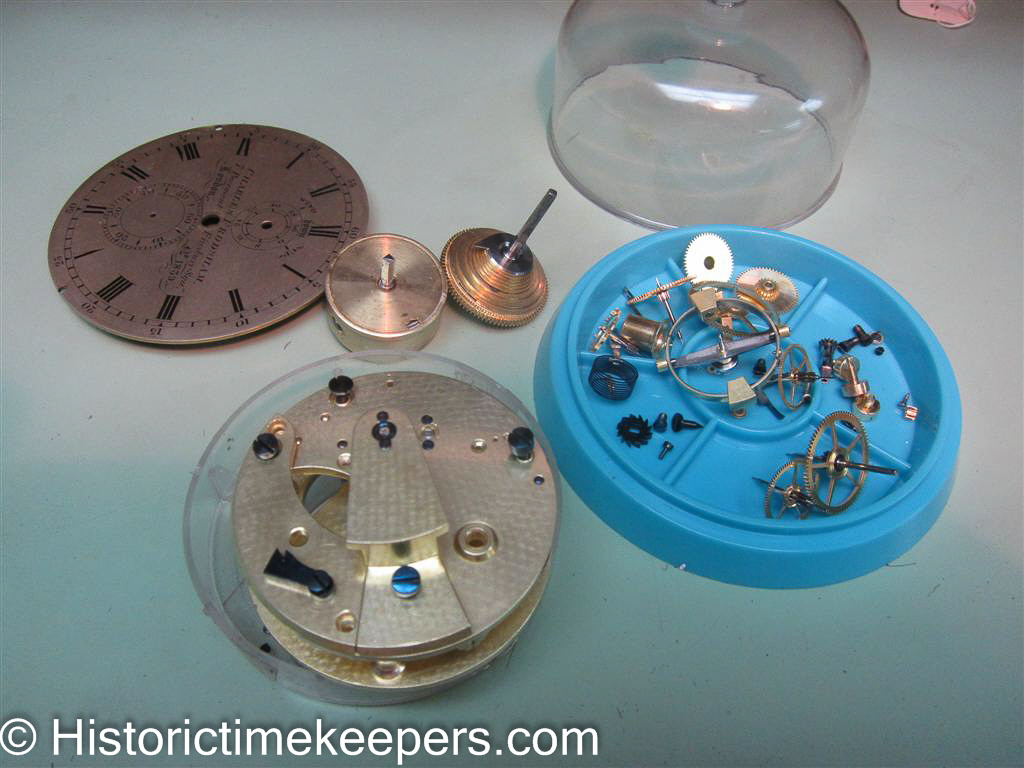
About mainsprings. They are expensive these days and many times need to have end hooks attached in order to adapt a new mainspring to a vintage watch. But, the mainspring is extremely important for providing consistent power to the escapement and is the beginning of precision timing. The other issue is that the old blue steel springs are now at least 50 years old and are fatigued and or rusted. It is not unusual to have a blue steel spring break within a couple months of service, even if a "new" blue steel spring is installed. Not only is this an inconvenience, it can result in actual damage to the watch. Here is a side by side comparison of a new stainless steel spring next to a fatigued blue steel spring taken out of a WWII pocket watch.
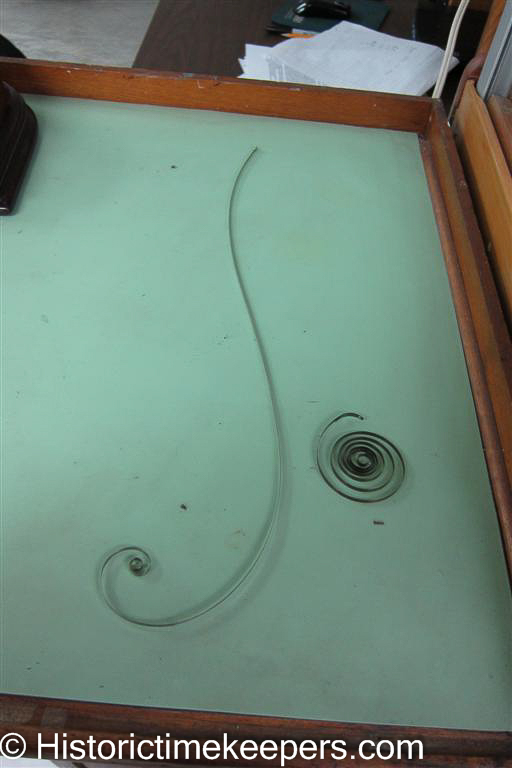
I never use Rodico (a sticky paste sold to watchmakers) for removing stains or foreign matter on a part that is ready for assembly. It leaves a residue and proper technique avoids the problem to begin with.
I use finger cots to avoid leaving oils from handling during assembly, I reclean any part that has been contaminated in the final cleaning machine. I use suction to remove dust that may settle into the movement.

Parts like dials and hands are kept in storage boxes while the watch is being serviced. Dials are wrapped in sterile tissue paper for protection.
To protect the finish on parts, I use bronze tweezers. I rarely use steel tweezers for anything during assembly.
I use fresh lubricants. When it comes to the escapement, I use a surface treatment (epilame) on the pallet jewels and escape wheel which the Swiss have proven keeps the oil where it is needed.
Parts DO fly away. Any watchmaker who sez he does not pray on the floor weekly (really looking for parts) is not truthful. To minimize the hassle, I use a roll top bench with the top left open only in the front. I keep the bench top clear of anything but what I am working on at the moment. These two practices minimize the time spent looking for a part amidst a jumble of movements and tools. I have also sealed every floor to vertical joint within 15 feet of my bench so that parts cannot try to hide. When found, they get sentenced to the final cleaner.
If appropriate, the screws are all refinished by hand and blued using the traditional method of heat (no chemicals or lacquers). The steel must be highly polished and chemically clean. It is then heated until the correct color is reached. This is actually an oxide that forms on the surface. It is not only decorative, it provides protection against corrosion. You can judge my consistency for yourself:
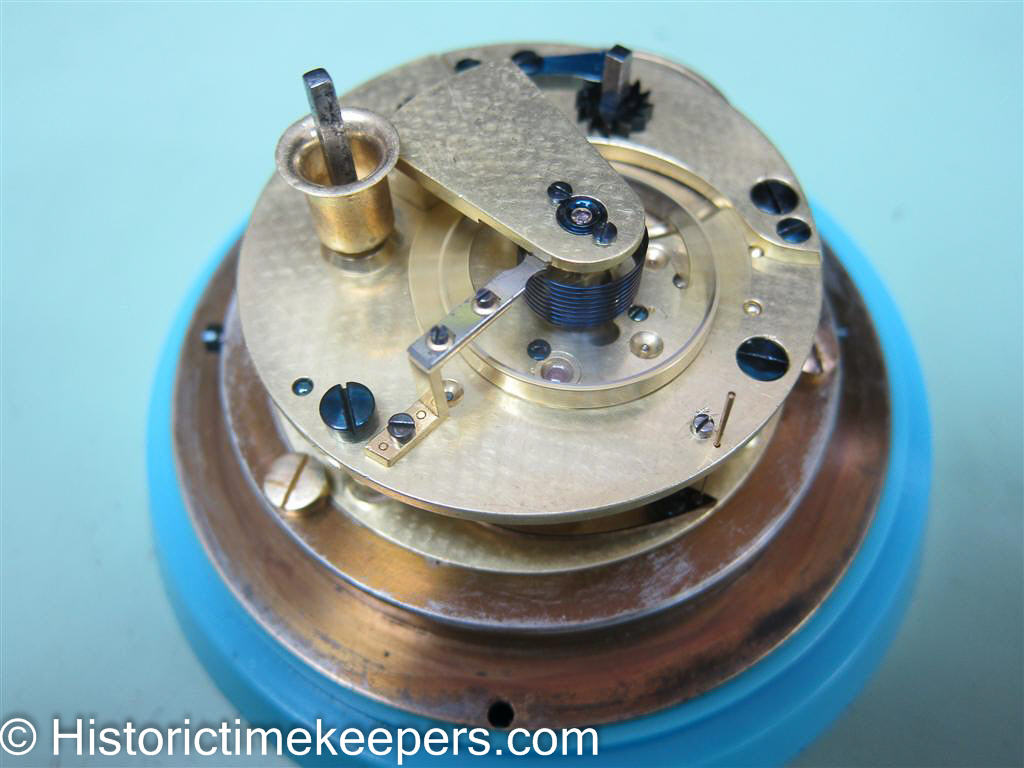
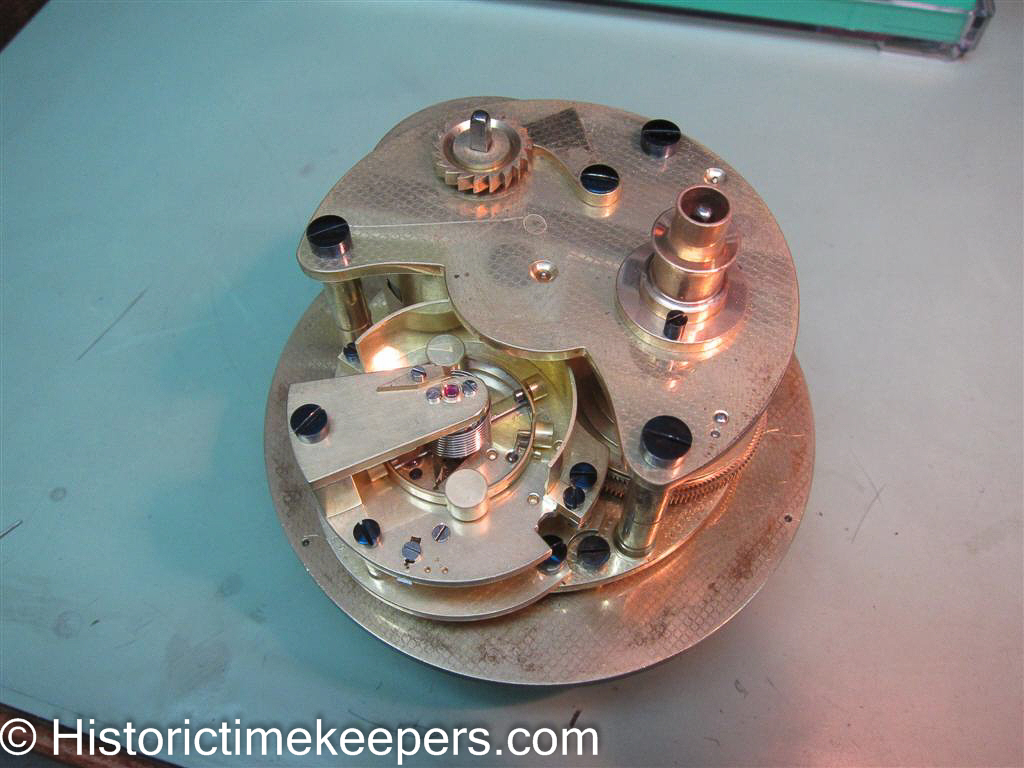
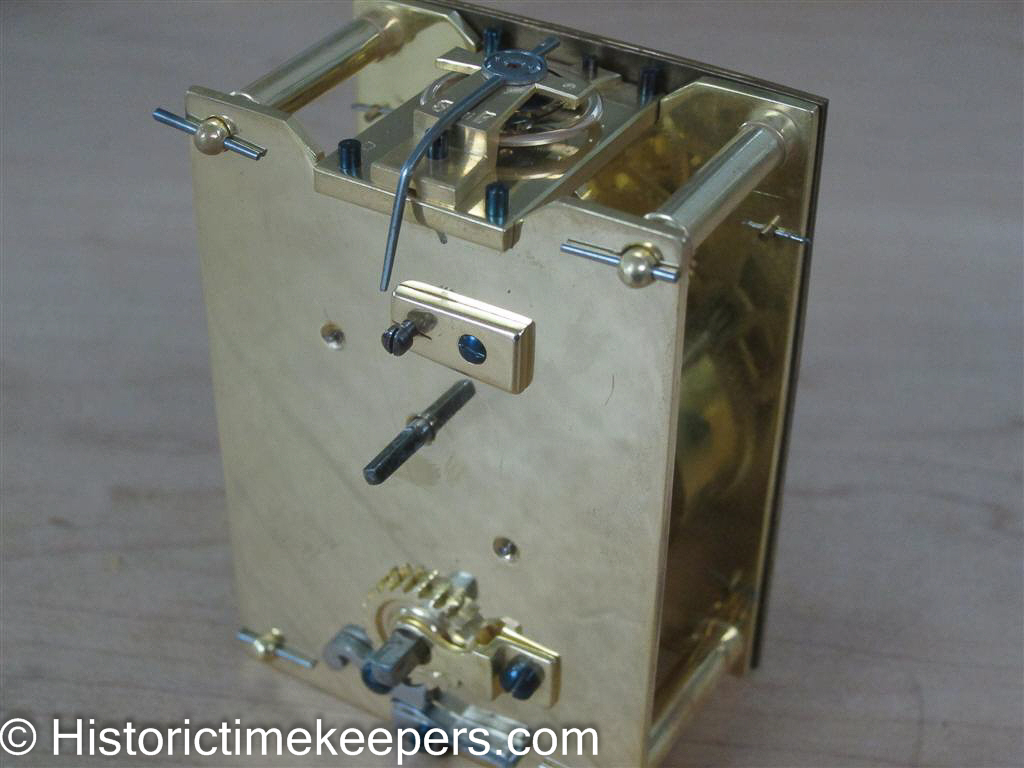
Upon assembly the timepiece is checked for performance on the timing machine, which reports information on the error rate, whether the beats are equal (beat error), and how much the balance assembly rotates (amplitude). All of these are important parameters of watch performance. However, it is not enough.

At this point, if it is appropriate to the piece, I adjust its rate to be within specifications for the number of positions specified for the model. For example, a precision watch such as an American Railroad watch originally was specified to keep equal rates across 5 or 6 positions (Dial up/down and then the stem held in various vertical positions). Using correct service procedures, it is possible to get most 100 year old Railroad watches to hold a rate that is within 15 seconds a day across positions. This means that it will be a consistent timekeeper when in use. The closer the positional rates in testing, the more reliable will be the rate in use.
I use 15 seconds a day for American RR watches because after 100 years of use, and the way many were abused by "watch fixers" in the last 40 years, it has seemed to be the most cost effective standard. Originally, these watches were specified to keep a rate difference of 5 seconds per day across position (Omega/Rolex automatic watch performance!). Indeed, I have had well treated examples that I could adjust to closer than that.
Part of adjusting high performance watches is checking and adjusting the escapement. This often means making minute adjustments to the various parts. This is the tool used to make precise adjustments to the pallet stones of the lever escapement to make the locks on the escape wheel teeth (what you hear as the tick) as light as possible and still safe. Please note this picture is old and I need to replace it with the way I do this under the microscope at my main bench.

Again, the above photo is old. I now do all adjustments under the microscope.
If the watch is an automatic, it needs to checked to ensure the autowind works properly and the watch runs its full allotted time (determined by the manufacturer).
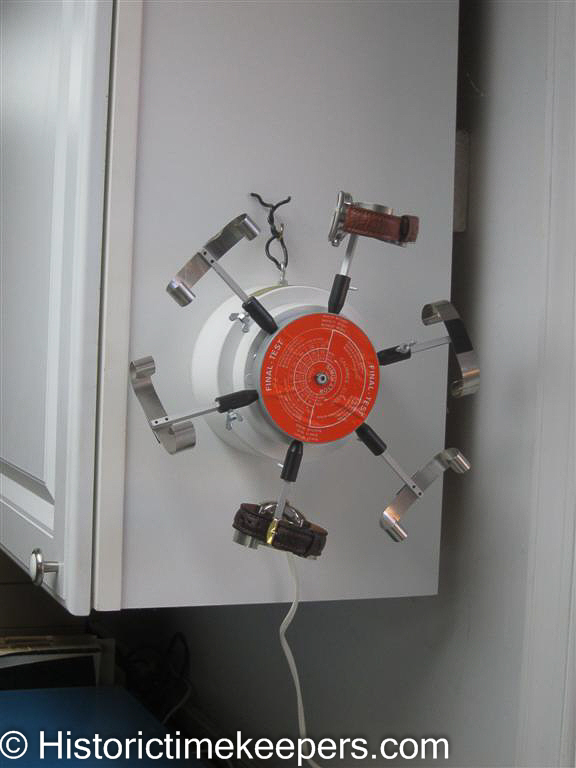
Also, just because the watch times out nicely on the machine (for 5 minutes or so), it is not proof the watch is functional. I test all timepieces for at least 5 days against a network corrected time signal I receive from the Naval Observatory.
Only after getting past these tests is the timepiece ready. I use a Mumford Timing Instrument to prepare the final report documenting the rate, beat error, amplitude and positional performance of the timepiece (again appropriate to the piece).
This report, plus any parts replaced, are returned with the piece.
All of these services are included in the prices stated for service. You really do get what you pay for.
A note about casing. You likely know my business is based on jobs others cannot tackle. I service modern watches primarily as a service to those who become my customers. I have chosen NOT to spend my capital on the latest casing and pressure testing equipment. I do test water resistant cases to 4 ATM. If a customer needs a case sealed to 12 ATM I refer them to others with the required equipment. Bear in mind that 1 ATM is 14.7 PSI. Most modern plumbing delivers water at 45 PSI. This means that even correctly sealed, it is strongly advised to remove your vintage watch while washing dishes or taking a shower; even if that watch is correctly sealed and meets the required standard of 3 ATM!
Finally, in the Swiss tradition I do what I can to stay in shape. Watchmaking is a sedentary occupation which makes it too easy to fall into poor health. Plus, being in shape does make a better watchmaker. My wife and I are trail maintainers on the Appalachian Trail.
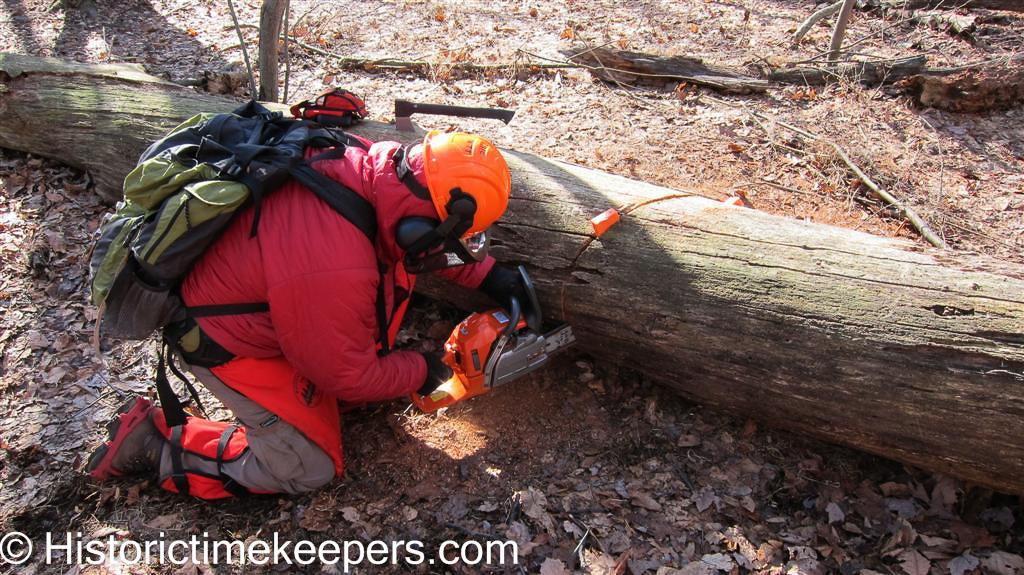
I cannot be responsible for someone else's work.